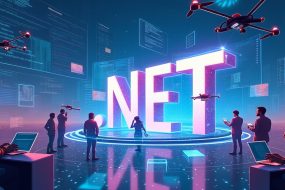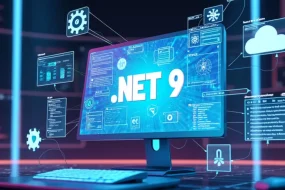

The digital transformation wave has revolutionized how businesses operate and compete. Organizations face challenges in connecting diverse devices across distributed networks effectively.
IoT app development services bridge operational gaps through integrated device communication systems. Development teams encounter complexities in managing data flows between devices efficiently.
As IoT experts, we understand the challenges of building robust infrastructure. Organizations require secure, scalable solutions to handle growing device networks.
Cloud based IoT applications provide the foundation for modern enterprise operations. Companies need reliable frameworks to process data from thousands of devices.
This blog explores how .NET development tackles IoT challenges. Readers will discover solutions for device management, cloud integration, and security.
Benefits of .NET in Bridging the Gap between Devices and the Cloud
.NET provides robust capabilities for developing IoT applications across diverse technological environments. The framework enables developers to create applications that handle device communication with cloud services.
The platform’s cross-platform compatibility ensures IoT applications run on various operating systems. Developers can leverage .NET Core to build applications that process data from IoT sensors.
Here are the top benefits of using .NET for IoT development:
- Built-in support for protocols like MQTT and AMQP facilitates reliable device-to-cloud communication
- Azure IoT Hub integration enables device management and bi-directional messaging at scale
- Memory optimization techniques in .NET ensure efficient processing of IoT sensor data
- Native compatibility with cloud services simplifies deployment and maintenance of IoT solutions
- The framework’s extensive libraries reduce development time for complex IoT implementations
- .NET’s threading model handles concurrent device connections without compromising system performance
- Robust security features protect sensitive data transmission between IoT devices and cloud
- Microsoft’s long-term support commitment ensures stability for enterprise IoT solutions
- The active developer community contributes to solving IoT-specific challenges through solutions
- Regular framework updates maintain compatibility with emerging IoT technologies and standards
The framework’s scalability allows organizations to expand their IoT infrastructure without performance issues. Companies implementing .NET for IoT benefit from comprehensive documentation and development tools.
Enterprise-Grade Dot Net Development Services: Powering IoT Solutions
Transforming Industries with Dot Net Development Services
Manufacturing companies integrate smart sensors to monitor production lines through connected systems. Organizations leverage cloud platforms to analyze data streams from multiple IoT endpoints. Dot NET development services streamline the implementation of industrial automation and monitoring solutions.

Here are key industry transformations enabled by .NET IoT solutions:
- Smart factories optimize production processes through automated data collection and analysis systems
- Healthcare providers enhance patient care with real-time monitoring and predictive analytics
- Transportation companies implement fleet management solutions with GPS tracking capabilities
- Agricultural enterprises deploy sensor networks for crop monitoring and automated irrigation
- The retail sector implements smart inventory management systems to track product movement.
Accelerating Digital Growth through Dot Net Development Services
Modern enterprises adopt IoT solutions to enhance operational efficiency and customer experiences. Dot NET development services enable businesses to implement scalable digital transformation initiatives.
Key areas where .NET IoT solutions drive digital growth:
- Cloud integration facilitates real-time data processing and advanced business intelligence capabilities
- Automated workflows streamline business operations and reduce manual intervention requirements
- Microservices architecture enables modular development and deployment of IoT applications
- API-first approach ensures seamless integration with existing enterprise systems
Organizations leverage IoT platforms to gather insights from connected devices and sensors. Digital transformation initiatives help businesses adapt to changing market demands efficiently.
Security-First Solutions with IoT App Development Services
Security measures protect IoT devices from unauthorized access and potential cyber threats. Cloud based IoT applications implement multiple layers of protection for sensitive data transmission.
Essential security features for IoT applications include:
- End-to-end encryption safeguards data communication between devices and cloud servers
- Multi-factor authentication prevents unauthorized access to device management systems
- Regular security audits identify vulnerabilities in IoT infrastructure and network connections
- Automated threat detection systems monitor network traffic for suspicious activities
Organizations implement role-based access control to manage device permissions and user rights. Advanced monitoring tools track device behavior patterns to detect potential security breaches.
Building Connected Ecosystems with IoT App Development Services
Connected devices form the backbone of modern industrial automation and smart systems. IoT platforms enable seamless communication between diverse devices across multiple operational environments.
Key components of connected IoT ecosystems:
- Device management platforms centralize control of distributed IoT sensors and equipment
- Data analytics tools process information streams from multiple connected devices simultaneously
- Integration frameworks connect legacy systems with modern IoT infrastructure components
- Communication protocols ensure reliable data exchange between devices and cloud servers
Smart buildings utilize sensor networks to optimize energy consumption and environmental conditions. Advanced monitoring systems track device performance metrics across the connected ecosystem.
Cloud Technology Integration
Modern Cloud Based IoT Applications for Enterprise Success
Enterprises integrate cloud platforms to process data from thousands of connected devices. IoT app development services enable organizations to build scalable solutions for data management.
Essential features of modern cloud-based IoT solutions:
- Real-time analytics engines process device data for immediate business insights
- Automated scaling capabilities adjust resources based on device communication loads
- Cloud storage systems maintain historical data for advanced pattern analysis
- Edge computing integration reduces latency in time-critical IoT applications
Advanced algorithms analyze device data to predict maintenance requirements and optimize operations. Cloud platforms provide centralized control over distributed IoT device networks worldwide.
Cloud Security Implementation
IoT infrastructures require robust security measures to protect sensitive data during transmission. Modern security protocols establish encrypted connections between cloud services and connected devices.
Critical security measures for cloud-based IoT systems:
- Zero-trust architecture ensures verification of every device accessing the network
- Automated security updates patch vulnerabilities across connected devices and cloud services
- Identity management systems control access levels for different user roles
- Real-time monitoring detects unusual patterns in device communication and data flow
Advanced encryption methods secure data storage and transmission across cloud platforms. Organizations implement multi-layer security protocols to prevent unauthorized access to IoT networks.
DevOps and Deployment
Continuous integration practices streamline the deployment of IoT applications across cloud environments. Development teams implement automated testing to ensure reliability of IoT device communications.
Essential DevOps practices for IoT deployments:
- Automated deployment pipelines ensure consistent updates across distributed IoT device networks
- Container orchestration manages scalable microservices for IoT application components
- Infrastructure as Code templates standardize cloud resource provisioning for IoT systems
- Monitoring tools track application performance metrics across development and production environments
Version control systems maintain code consistency across multiple development teams and environments. Release management processes coordinate updates between cloud services and IoT devices.
Maintenance and Support
Support teams monitor IoT system health through automated diagnostic tools and alerts. Regular maintenance schedules ensure optimal performance of cloud-based IoT infrastructure components.
Key aspects of IoT system maintenance:
- Predictive analytics identify potential device failures before they impact system performance
- Automated backup systems protect critical data across distributed IoT networks
- Remote troubleshooting tools enable rapid resolution of device connectivity issues
- Performance optimization algorithms maintain efficient resource utilization in cloud environments
Technical support teams provide round-the-clock monitoring of critical IoT infrastructure components. System updates deploy seamlessly across device networks to maintain security standards.
IoT Infrastructure Solutions
Device Management Framework
Centralized management platforms provide complete visibility into connected device networks and operations. Device registration systems automate the on boarding process for new IoT equipment.
Essential components of device management:
- Remote configuration tools enable bulk updates across distributed IoT device networks
- Device health monitoring systems track performance metrics and resource utilization
- Asset tracking interfaces maintain real-time location data for mobile IoT devices
- Firmware management tools coordinate updates across different device types and versions
Administrative dashboards provide detailed insights into device status and operational parameters. Custom reporting tools generate analytics based on device performance and usage patterns.
Data Processing and Analytics
Real-time data processing enables immediate insights from connected device sensor networks. IoT app development services streamline the integration of analytics tools with device networks.
Core features of data processing systems:
- Machine learning algorithms analyze device data patterns for predictive maintenance
- Stream processing engines handle high-volume data from multiple IoT sensors
- Data visualization tools transform complex device metrics into actionable insights
- Edge computing modules process time-sensitive data near the source devices
Advanced analytics platforms identify trends and anomalies in device operation patterns. Cloud-based processing systems scale automatically to handle increasing data volumes.
Edge Computing Integration
Edge devices process data locally to reduce latency in time-sensitive IoT operations. Cloud based IoT applications integrate seamlessly with edge computing nodes for efficient processing.
Key benefits of edge computing integration:
- Local data processing reduces bandwidth consumption and cloud storage requirements
- Real-time analytics enable immediate responses to critical device events
- Distributed computing nodes ensure continuous operation during network connectivity issues
- Smart caching mechanisms optimize data transfer between edge devices and cloud
Edge computing architectures enhance system reliability by maintaining local processing capabilities. Network optimization tools balance workloads between edge nodes and cloud servers.
Performance Monitoring
Monitoring systems track real-time performance metrics across distributed IoT device networks. Advanced analytics tools process device telemetry data to identify operational bottlenecks.
Essential performance monitoring features:
- Real-time dashboards display critical metrics from connected devices and systems
- Automated alert systems notify administrators about performance threshold violations
- Resource utilization tracking ensures optimal distribution of computing workloads
- Historical performance analysis helps identify trends and potential system improvements
Custom reporting tools generate detailed insights into device and network performance metrics. Load balancing systems optimize resource allocation based on performance monitoring data.
Conclusion
IoT development continues to evolve, creating new opportunities for business transformation. Modern enterprises leverage .NET frameworks to build robust IoT solutions at scale.
Key takeaways for IoT development success:
- Cloud integration enables scalable processing of data from distributed device networks
- Security implementations protect sensitive data across IoT infrastructure components
- Edge computing solutions optimize performance for time-critical IoT applications
- DevOps practices ensure reliable deployment and maintenance of IoT systems
Organizations must adapt their infrastructure to support growing IoT implementation demands. Development teams should focus on creating flexible architectures for future IoT expansion.
Adit Sheth
Adit Seth, CTO of Virtual Coders, is an accomplished engineer focused on software development and emerging technologies. His articles cover innovative coding practices and tech advancements, aiming to educate and inspire readers in the digital landscape.
Search
Recent Post
How To Hire A Dedicated Angular JS
- 13 hours ago
- 8 min read
Hire Dedicated Dot Net Developers – A
- 4 weeks ago
- 13 min read
Why You Should Consider Virtual Coders as
- 2 months ago
- 7 min read







